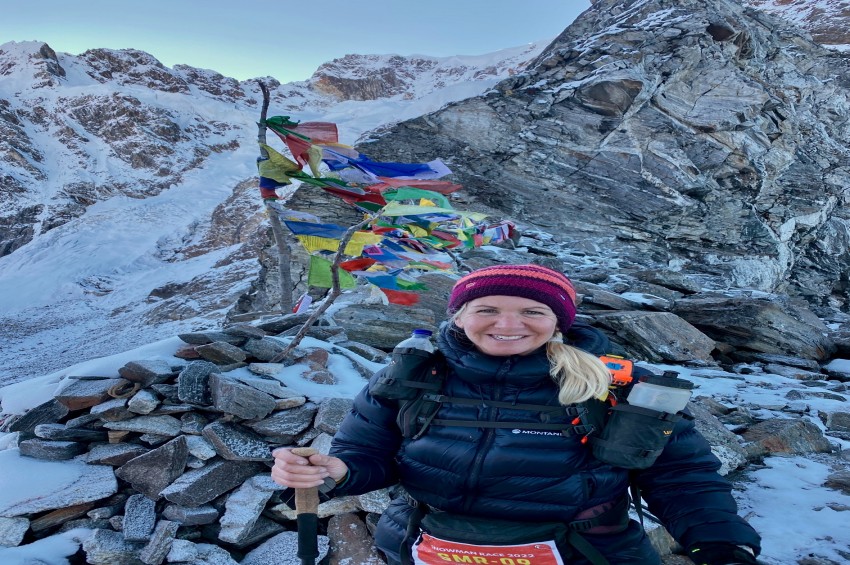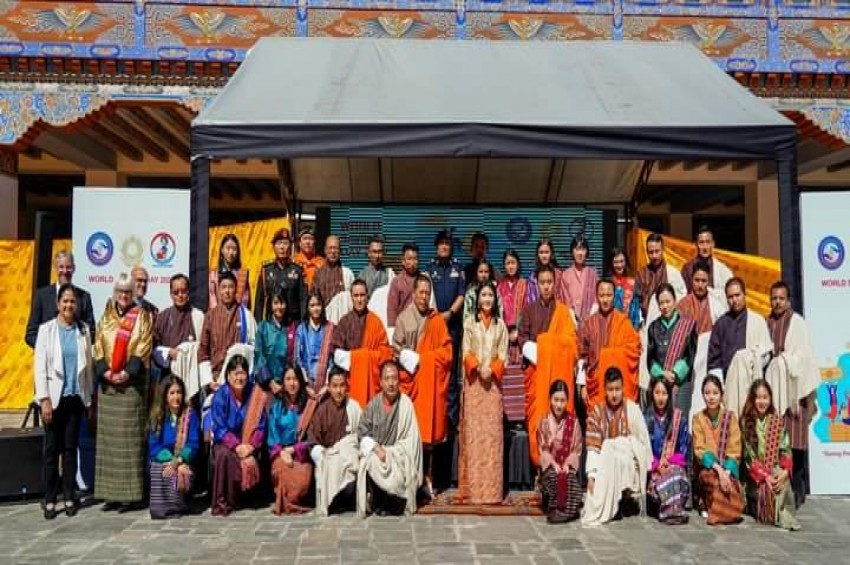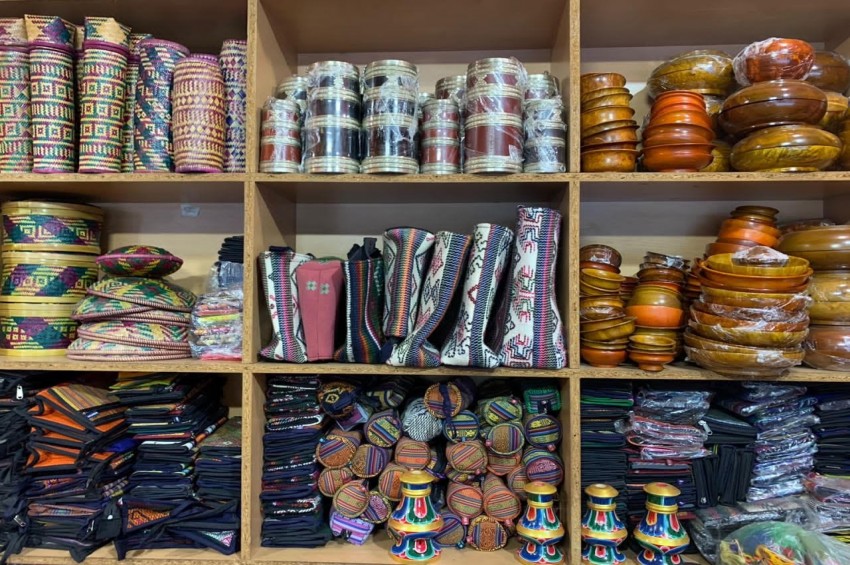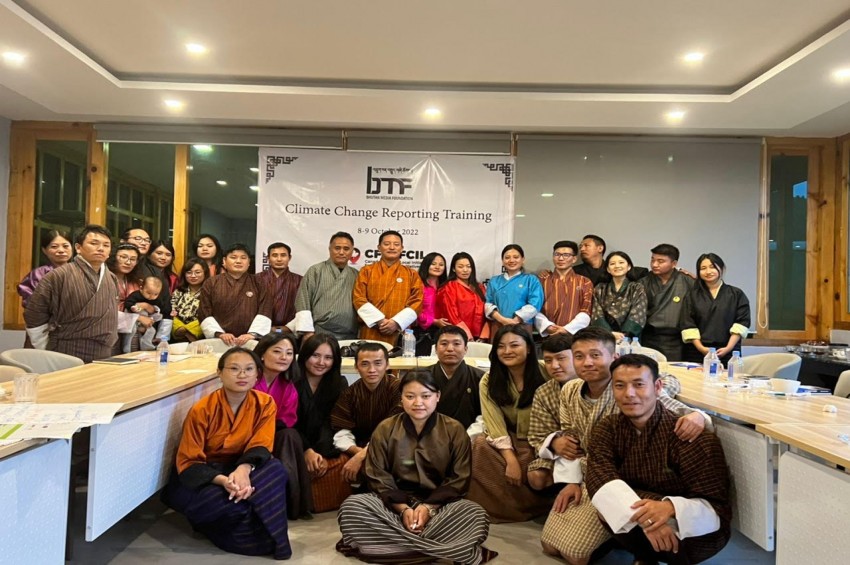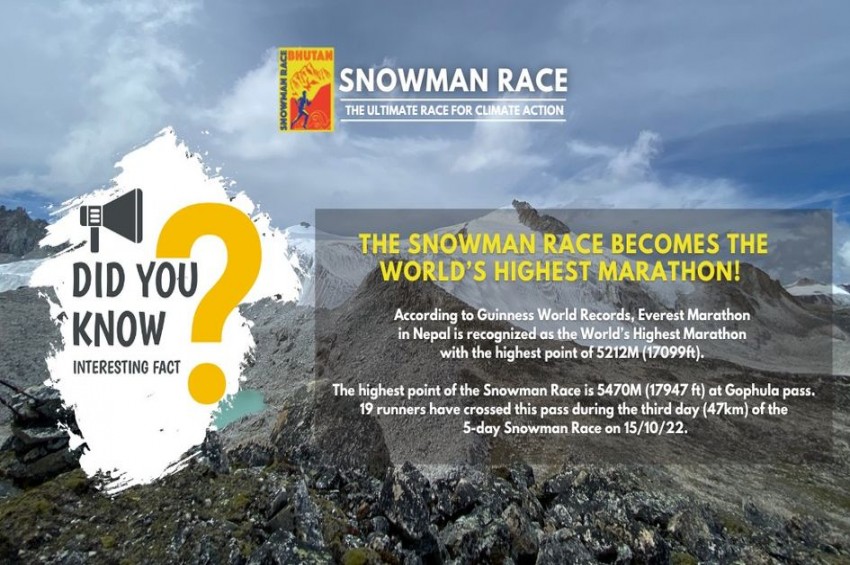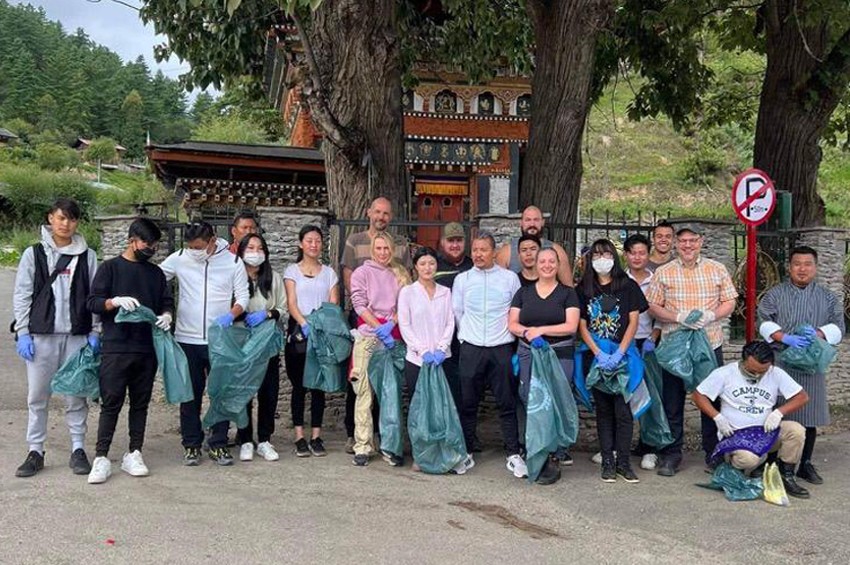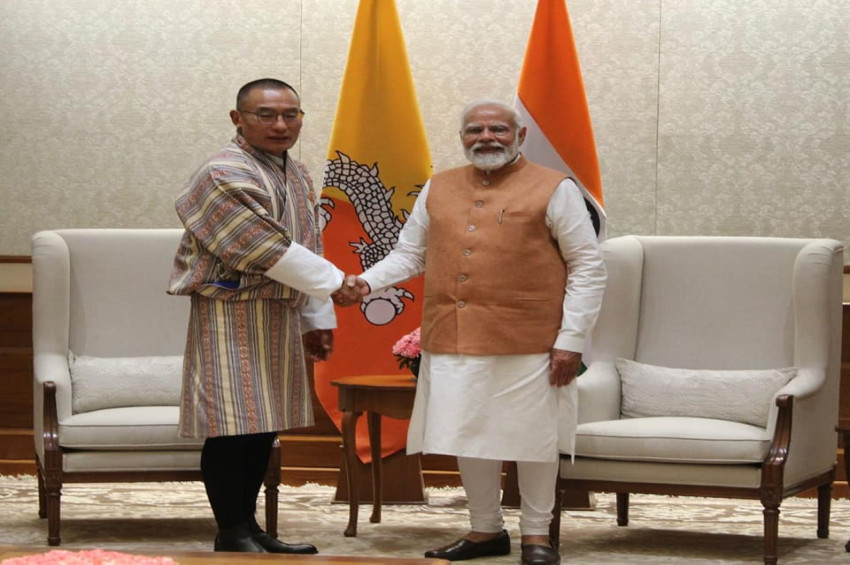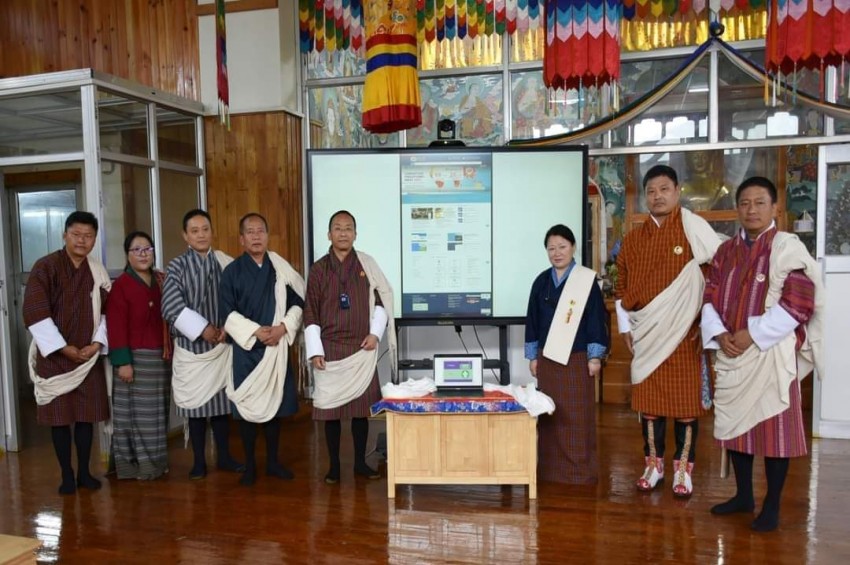The athlete felt like she had walked through the looking glass of Alice in wonderland to a world that is part reality and part fantasy fairytale.
“Bhutan is a beautiful country: the environment, people, culture, and traditions. One of the last pristine places on earth. This needs to be preserved. And we all need to play our role in doing that,” said Holly Zimmerman, one of the snowman race runners.
Holly Zimmerman, a 52-year-old ultra-marathon runner from Germany, is the oldest runner out of the 29 runners for Bhutan’s first edition of the snowman race. She attempted to conquer the ancient snowman trek which a normal person takes a minimum of three weeks in five days long snowman race; the ultimate race for climate action.
Zimmerman’s age is just an unstoppable factor for her to challenge herself for a greater cause. She stated: “My birth certificate confirms, I’m not twenty-nor even thirty-something, but my inner clock tells me I just turned 26 years old,”
Holly is a tough woman, a mother of four with more than a hundred traces of race history starting from 2010. Her greatest accomplishment includes the 257 kilometers (km) Marathon des Sables across the Sahara Desert and the Polar Circle Marathon.
In 2018, Holly became the first international woman in the Everest Marathon, then the highest marathon in the world with an elevation of 5,212 meters above sea level (masl) as the highest point.
But on the second day of the snowman race, Holly’s heart and head had a tug-of-war. Her head won, hurting her heart as she stood behind the race. Thus, missing the opportunity set her feet on the world’s new record-breaking highest marathon point; Gophula Pass at 5,407 masl. But she’s not the only one, only19 runners out of 29 could cross the pass on the third and the toughest of the snowman racecourse.
Nevertheless, Zimmerman shared that the racecourse on the first day began with 20 kilometers (km) of forestry road. She said, “It was easy to run on and fast since we were still at a relatively low elevation, but then we entered a valley that was ankle-deep full of mud for many miles.”
Holly claimed that the runners were not able to avoid the muddy trek. Thus, runners tried jumping from rock to rock. She said, “But that was not always possible.”.
The runners also had many streams to cross. Holly recalls how everything was wet from the recent rains. Holly realized that after the first checkpoint at Rodophu, the trail began to gain altitude steeply. She said, “Running was all but impossible. Higher and higher, over stony passes strung with colorful prayer flags.”
She noted how it began to get bitterly cold when the sun set around 6 pm, approximately after 12 hours since the race started at Gasa Dzong base.
To add to the crispy cold temperature, it began to rain lightly, which quickly turned to snow. She said, “The trail markings were difficult to see and I needed to use GPS to navigate the track. After 13.5 hours I finally reached the first night halt, cold and hungry.”
Holly was given a quick medical check and her vitals were good. She stated that the nurse was surprised to see that her oxygen saturation was 93 percent. “It’s higher than any of the other runners.” Meaning that her body was able to adapt to high altitude.
Shortly, Holly went to her tent, changed into dry clothes, and pulled her sleeping bag out of her backpack. She was still cold for a long time but eventually fell into a light sleep.
When she woke up at 4 am and packed her bags for the 6 am start, she said that she felt quite good.
She added, “But then during the first climb, over the Gangla Karchung pass at 5,280 masl, I realized that my pace was very slow.”
Although Zimmerman showed no symptoms of high-altitude sickness, at that elevation she simply would not move fast.
She said, “I was afraid that I would not make the subsequent daily cutoffs, being out on the trails until late into the night, so I returned to camp 1 at Narithang and retired from the race.”
Holly and four other international ultra-marathon runners withdrew safely, stable, and in good spirits on the second day of the snowman race starting at the first night halt in Narithang and resting at Lhedi.
On her Instagram feed (holly. zimmermann), she stated: “It was a decision of the head, not the heart. For that reason, my heart is hurting today. And I told myself beforehand that I would only stop if I had altitude sickness or a broken bone. But I had neither. Physically I felt fine.”
“Tired of course, from the long day 47 kilometers 3,300 m elevation climb, waking up at 2,200 masl and going to bed at 4,800 masl.”
“I was on my feet for 13.5 hours, the last two hours in the dark, cold, and a bit scared, navigating by GPS since the course markings were difficult to find at the beginning of snowfall.”
“Towards the end, I was escorted by a Bhutanese soldier who had been stationed along the course.”
It wasn’t until July 29, this year that Holly Zimmerman received the Letter of Acceptance into the Snowman Race. She said that her preparation time for this race was limited. She said,” Most long-distance runners train for endurance year-round, which is also the case for me.”
Her training strategy for the Snowman Race simply involved adding more strength and altitude training to her existing program. To prepare for the high altitude she rented an altitude-simulation compressor and tent, which she erected over her bed, allowing herself to sleep at progressively higher altitudes over the four weeks before traveling to Bhutan.
Zimmerman became one of the first women to reach the finish line during the ultra-marathon race in Mt. Everest, or more specifically the Khumbu Valley, Nepal in 2018. She claimed that the differences she noticed between the Snowman Race and Everest marathon were stark.
She said, “The trails in Nepal are much more heavily traveled, better marked, and considerably easier to traverse. Whereas the Snowman Trek is remote, pristine, and wild.”
Holly Zimmerman personifies the urgency of climate action through the story of Karma Yangden from the remote mountain village of Laya and the snowman race’s female winner.
Holly narrated how Karma’s community suffered the rage of mother nature fueled by climate change. She stated: “Not long ago there was a devastating landslide, believed to have been caused by the effects of glacial melting, that killed many of Karma’s family members. Her community relies on the colder climate to support the ecosystem that they have cultivated for centuries.”
For now, Holly Zimmerman is excited to share her experience and stories but unsure whether or not she'd return for another edition of the Snowman Race or give her spot to a new ambassador for climate change.
She said, “Only time will tell. I don’t believe that if I did choose to run it again that I would need to acclimatize longer in Bhutan but I would certainly train harder and faster in my own country of Germany.”
“Even then, I don’t believe that any international racers could beat the Bhutanese. They are much too strong in their homeland and they deserve the podium to themselves,” added Holly Zimmerman.
Holly also believes that the snowman race is bigger than the competition, prizes, trophies, or medals. Moreover, she claimed that none of the runners expected any prizes, cash or otherwise. “Although it was a generous gesture from the organization, it didn’t influence any of our decisions to participate,” she said.
As a climate change ambassador, Holly said, “As a carbon-negative country, Bhutan has done nothing to contribute to climate change but it’s drastically feeling the effects.”
Although she had to take the hardest decision and retired from the race, Holly still wonders what could have happened if she continued. She can’t stop wondering if she could have reached the finish line or maybe evacuated by helicopters like some other runners.
Holly also claimed that the last two weeks in Bhutan as a snowman race runner have felt like she has walked through the looking glass of Alice in wonderland to a world that is part reality and part fantasy fairytale.
She’s also a motivational speaker and an author writing about her adventurous race experiences.
“Bhutan is a beautiful country: the environment, people, culture, and traditions. One of the last pristine places on earth. This needs to be preserved. And we all need to play our role in doing that,” said Holly Zimmerman, one of the snowman race runners.
Holly Zimmerman, a 52-year-old ultra-marathon runner from Germany, is the oldest runner out of the 29 runners for Bhutan’s first edition of the snowman race. She attempted to conquer the ancient snowman trek which a normal person takes a minimum of three weeks in five days long snowman race; the ultimate race for climate action.
Zimmerman’s age is just an unstoppable factor for her to challenge herself for a greater cause. She stated: “My birth certificate confirms, I’m not twenty-nor even thirty-something, but my inner clock tells me I just turned 26 years old,”
Holly is a tough woman, a mother of four with more than a hundred traces of race history starting from 2010. Her greatest accomplishment includes the 257 kilometers (km) Marathon des Sables across the Sahara Desert and the Polar Circle Marathon.
In 2018, Holly became the first international woman in the Everest Marathon, then the highest marathon in the world with an elevation of 5,212 meters above sea level (masl) as the highest point.
But on the second day of the snowman race, Holly’s heart and head had a tug-of-war. Her head won, hurting her heart as she stood behind the race. Thus, missing the opportunity set her feet on the world’s new record-breaking highest marathon point; Gophula Pass at 5,407 masl. But she’s not the only one, only19 runners out of 29 could cross the pass on the third and the toughest of the snowman racecourse.
Nevertheless, Zimmerman shared that the racecourse on the first day began with 20 kilometers (km) of forestry road. She said, “It was easy to run on and fast since we were still at a relatively low elevation, but then we entered a valley that was ankle-deep full of mud for many miles.”
Holly claimed that the runners were not able to avoid the muddy trek. Thus, runners tried jumping from rock to rock. She said, “But that was not always possible.”.
The runners also had many streams to cross. Holly recalls how everything was wet from the recent rains. Holly realized that after the first checkpoint at Rodophu, the trail began to gain altitude steeply. She said, “Running was all but impossible. Higher and higher, over stony passes strung with colorful prayer flags.”
She noted how it began to get bitterly cold when the sun set around 6 pm, approximately after 12 hours since the race started at Gasa Dzong base.
To add to the crispy cold temperature, it began to rain lightly, which quickly turned to snow. She said, “The trail markings were difficult to see and I needed to use GPS to navigate the track. After 13.5 hours I finally reached the first night halt, cold and hungry.”
Holly was given a quick medical check and her vitals were good. She stated that the nurse was surprised to see that her oxygen saturation was 93 percent. “It’s higher than any of the other runners.” Meaning that her body was able to adapt to high altitude.
Shortly, Holly went to her tent, changed into dry clothes, and pulled her sleeping bag out of her backpack. She was still cold for a long time but eventually fell into a light sleep.
When she woke up at 4 am and packed her bags for the 6 am start, she said that she felt quite good.
She added, “But then during the first climb, over the Gangla Karchung pass at 5,280 masl, I realized that my pace was very slow.”
Although Zimmerman showed no symptoms of high-altitude sickness, at that elevation she simply would not move fast.
She said, “I was afraid that I would not make the subsequent daily cutoffs, being out on the trails until late into the night, so I returned to camp 1 at Narithang and retired from the race.”
Holly and four other international ultra-marathon runners withdrew safely, stable, and in good spirits on the second day of the snowman race starting at the first night halt in Narithang and resting at Lhedi.
On her Instagram feed (holly. zimmermann), she stated: “It was a decision of the head, not the heart. For that reason, my heart is hurting today. And I told myself beforehand that I would only stop if I had altitude sickness or a broken bone. But I had neither. Physically I felt fine.”
“Tired of course, from the long day 47 kilometers 3,300 m elevation climb, waking up at 2,200 masl and going to bed at 4,800 masl.”
“I was on my feet for 13.5 hours, the last two hours in the dark, cold, and a bit scared, navigating by GPS since the course markings were difficult to find at the beginning of snowfall.”
“Towards the end, I was escorted by a Bhutanese soldier who had been stationed along the course.”
It wasn’t until July 29, this year that Holly Zimmerman received the Letter of Acceptance into the Snowman Race. She said that her preparation time for this race was limited. She said,” Most long-distance runners train for endurance year-round, which is also the case for me.”
Her training strategy for the Snowman Race simply involved adding more strength and altitude training to her existing program. To prepare for the high altitude she rented an altitude-simulation compressor and tent, which she erected over her bed, allowing herself to sleep at progressively higher altitudes over the four weeks before traveling to Bhutan.
Zimmerman became one of the first women to reach the finish line during the ultra-marathon race in Mt. Everest, or more specifically the Khumbu Valley, Nepal in 2018. She claimed that the differences she noticed between the Snowman Race and Everest marathon were stark.
She said, “The trails in Nepal are much more heavily traveled, better marked, and considerably easier to traverse. Whereas the Snowman Trek is remote, pristine, and wild.”
Holly Zimmerman personifies the urgency of climate action through the story of Karma Yangden from the remote mountain village of Laya and the snowman race’s female winner.
Holly narrated how Karma’s community suffered the rage of mother nature fueled by climate change. She stated: “Not long ago there was a devastating landslide, believed to have been caused by the effects of glacial melting, that killed many of Karma’s family members. Her community relies on the colder climate to support the ecosystem that they have cultivated for centuries.”
For now, Holly Zimmerman is excited to share her experience and stories but unsure whether or not she'd return for another edition of the Snowman Race or give her spot to a new ambassador for climate change.
She said, “Only time will tell. I don’t believe that if I did choose to run it again that I would need to acclimatize longer in Bhutan but I would certainly train harder and faster in my own country of Germany.”
“Even then, I don’t believe that any international racers could beat the Bhutanese. They are much too strong in their homeland and they deserve the podium to themselves,” added Holly Zimmerman.
Holly also believes that the snowman race is bigger than the competition, prizes, trophies, or medals. Moreover, she claimed that none of the runners expected any prizes, cash or otherwise. “Although it was a generous gesture from the organization, it didn’t influence any of our decisions to participate,” she said.
As a climate change ambassador, Holly said, “As a carbon-negative country, Bhutan has done nothing to contribute to climate change but it’s drastically feeling the effects.”
Although she had to take the hardest decision and retired from the race, Holly still wonders what could have happened if she continued. She can’t stop wondering if she could have reached the finish line or maybe evacuated by helicopters like some other runners.
Holly also claimed that the last two weeks in Bhutan as a snowman race runner have felt like she has walked through the looking glass of Alice in wonderland to a world that is part reality and part fantasy fairytale.
She’s also a motivational speaker and an author writing about her adventurous race experiences.

